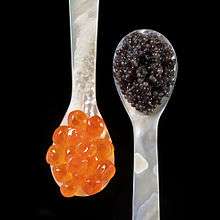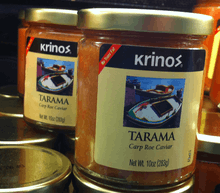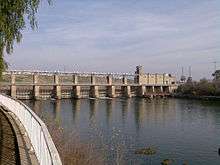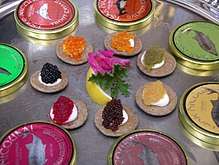Caviar
Caviar (less often, caviare; from Persian: خاویار, romanized: xâvyâr, lit. 'egg-bearing') is a food consisting of salt-cured roe of the family Acipenseridae. Caviar is considered a delicacy and is eaten as a garnish or a spread.[1] The roe can be "fresh" (non-pasteurized) or pasteurized, with pasteurization reducing its culinary and economic value.[2]


Traditionally, the term caviar refers only to roe from wild sturgeon in the Caspian Sea and Black Sea[3] (Beluga, Ossetra and Sevruga caviars). Depending on the country, caviar may also be used to describe the roe of other species of sturgeon or other fish such as salmon, steelhead, trout, lumpfish, whitefish,[4] or carp.[5][6][7]
Terminology

_(cropped).jpg)


According to the United Nations' Food and Agriculture Organization, roe from any fish not belonging to the Acipenseriformes order (including Acipenseridae, or sturgeon sensu stricto, and Polyodontidae or paddlefish) are not caviar, but "substitutes of caviar."[8] This position is also adopted by the Convention on International Trade in Endangered Species of Wild Fauna and Flora,[9] the World Wide Fund for Nature,[10] the United States Customs Service,[11] and France.[12]
The term caviar is sometimes used as a euphemism to describe dishes that are perceived to resemble caviar, such as "eggplant caviar" (made from eggplant) and "Texas caviar" (made from black-eyed peas).
History
Caviar and sturgeon from the Sea of Azov began reaching the tables of aristocratic and noble Byzantine Greeks in the 10th century, after the commencement of large-scale trading between the Byzantine Empire and Kievan Rus'.[13]
Varieties
The main types of caviar are Beluga, Sterlet, Kaluga hybrid, American osetra, Ossetra, Siberian sturgeon and Sevruga. The rarest and costliest is from beluga sturgeon that swim in the Caspian Sea, which is bordered by Iran, Kazakhstan, Russia, Turkmenistan, and Azerbaijan. Wild caviar production was suspended in Russia between 2008 and 2011 to allow wild stocks to replenish. Azerbaijan and Iran also allow the fishing of sturgeon off their coasts. Beluga caviar is prized for its soft, extremely large (pea-size) eggs. It can range in color from pale silver-gray to black. It is followed by the small golden sterlet caviar which is rare and was once reserved for Russian, Iranian and Austrian royalty. Next in quality is the medium-sized, light brown to rich brown Ossetra, also known as Russian caviar. Others in the quality ranking are the gray sevruga caviar, the Chinese Kaluga caviar, and the American osetra. The Siberian variety with black beads is similar to sevruga and is popular because of its reduced (5 years) harvest period, but it has a higher brine content than other kinds. The Chinese Kaluga hybrid varies in color from dark gray to light golden green and is a close cousin of beluga caviar.
Quality factors and cost
An expensive caviar example at 1 kilogram (2.2 lb) sold for £20,000 (then $34,500) is the Iranian 'Almas' product (from Persian: الماس, "diamond") produced from the eggs of a rare albino sturgeon between 60–100 years old from the southern Caspian Sea.[14] Wild beluga sturgeon caviar from the Caspian Sea was priced in 2012 at $16,000 per 1 kilogram (35 oz).[15] Cheaper alternatives have been developed from the roe of whitefish and the North Atlantic salmon.
Conventional sturgeon caviar was priced in 2014 at about $105 per 1 ounce (28 g) and from albino sturgeon up to $800 per ounce.[16] Other quality factors are texture – with firmness having higher quality value – flavor qualities, such as creaminess, butter taste, and brine or mild fish finish, and whether the caviar was taken from the fish by massage (higher value) rather than by killing it.[16]
Industry
China
China has emerged as the leading producer, accounting for 60% of the world production in caviar.[17] The largest caviar company in the world is the Chinese brand Kaluga Queen, which cultivates sturgeon at Qiandao Lake in Zhejiang.[18]
Iran
Iran is a substantial producer of caviar. Iranian caviar is collected from sturgeons near Bandar Torkaman.

Israel
Kibbutz Dan in Israel[19] produces 4 tons of caviar a year. The farm is fed by the Dan River, a tributary of the Jordan River.[20]
Italy
Beluga sturgeon were common in the Po river in Italy in the 16th century, and were used to produce caviar.
Cristoforo da Messisbugo in his book Libro novo nel qual si insegna a far d'ogni sorte di vivanda, Venice, 1564, at page 110, gave the first recorded recipe in Italy about extraction of the eggs from the roe and caviar preparation "to be consumed fresh or to preserve".[21] The writer and voyager Jérôme Lalande in his book "Voyage en Italie", Paris, 1771, vol. 8 page 269, noted that many sturgeon were caught in the Po delta area in the territory of Ferrara.[22] In 1753 a diplomatic war broke out between the Papal States, governing the Ferrara territory, and the Venetian Republic about sturgeon fishing rights in the Po river, the border between the two states.[23] From about 1920 and until 1942 there was a shop in Ferrara, named "Nuta" from the nickname of the owner Benvenuta Ascoli, that processed all the sturgeons caught in the Po river for caviar extraction, using an elaboration of the original Messisbugo recipe, and shipped it to Italy and Europe. Production was sporadically continued by a new owner until 1972, when sturgeon stopped swimming up the Po river. Since 2015, some sturgeon have reappeared in the Po. [24]
Currently, Italian caviar is obtained almost entirely from bred sturgeons. The caviar production is concentrated predominantly in Brescia, which is considered the capital of Italian caviar:[25] in this area, in Calvisano, is located the world's largest sturgeons farm[26] that produces annually 25 tonnes of caviar.[25] Italian caviar is generally the most sold and appreciated in the world: Italy is the world's leading producer.[27]
Madagascar
Madagascar is the first African country that produces and exports caviar since 2018.[28]
Malaysia
In Malaysia, caviar production is relatively new and smaller in scale. Caviar is harvested from farmed sturgeon fish in Tanjung Malim, Perak. The caviar produced here is marketed as "tropical caviar".[29] The first Malaysian brand of tropical caviar was launched in March 2019.[30]
Moldova (Transnistria)
In recent years Transnistria built and put into operation a modern sturgeon complex for caviar production, producing natural black caviar of sterlet, bester, Russian sturgeon, and beluga. The design capacity of the fish-breeding zone is equal to 50-80 tons of commodity fish and 5 tons of caviar a year.[31]
North America
In the early 20th century, Canada and the United States were the major caviar suppliers to Europe; they harvested roe from the lake sturgeon in the North American midwest, and from the shortnose sturgeon and the Atlantic sturgeon spawning in the rivers of the Eastern coast of the United States. The American caviar industry got started when Henry Schacht, a German immigrant, opened a business catching sturgeon on the Delaware River. He treated his caviar with German salt and exported a great deal of it to Europe. At around the same time, sturgeon was fished from the Columbia River on the west coast, also supplying caviar. At the time, American caviar was so plentiful that it was given away at bars with the intent of inducing or prolonging thirst in patrons.[32]
Today, the shortnose sturgeon is rated Vulnerable in the IUCN Red List of endangered species and rated Endangered per the Endangered Species Act. With the depletion of Caspian and Black Sea caviar, production of farmed or "sustainable" caviar[33] has greatly increased. In particular, northern California is reported to account for 70% to 80% of U.S. production.[34]
In Canada, a sturgeon farm called Target Marine Hatcheries is now the first producer of organic caviar in North America called "Northern Divine".[35]
Russia
In the wake of over-fishing, the harvest and sale of black caviar was banned in Russia in 2007.[36] The ban on sturgeon fishing in the Caspian Sea has led to the development of aquaculture as an economically viable means of commercial caviar production.[37]
Saudi Arabia
Caviar Court, in Dammam, Saudi Arabia, was established in 2001 and began harvesting caviar in 2007. It produced about five tons per year in 2011 and is building a larger facility in Abu Dhabi hoping to produce 35 tons by 2015.[38]
Spain

The 17th-century book Don Quixote mentions "cavial"[39][40] in a banquet of German pilgrims. Until 1992, sturgeons and caviar were collected at the lower parts of rivers Guadalquivir, Ebro, Duero and Tajo. From 1932 to 1970, the Ybarra family had a factory in Coria del Río.[41] Overfishing, pollution and the Alcalá del Río dam eliminated the wild population of Acipenser naccarii. In Spain, a fish farm called Caviar de Riofrío[42] produces organic caviar[43] at Loja, Granada, Andalusia.
United Kingdom
The British Royal family has held a long affinity with the sturgeon since 1324, when Edward II decreed it a Royal fish, whereby all sturgeons found within the foreshore of the Kingdom are decreed property of the monarch.
Uruguay
As well as Canada and the United States, Uruguay has become a major producer and exporter.[44]
Ecology
Over-fishing, smuggling and pollution caused by sewage entry into the Caspian Sea have considerably reduced the sea's sturgeon population.[45]
In September 2005, the United States Fish and Wildlife Service banned the import of Caspian Sea Beluga caviar to protect the endangered Beluga sturgeon; a month later, the ban was extended to include Beluga caviar from the entire Black Sea basin. In January 2006, the Convention on the International Trade in Endangered Species of Wild Flora and Fauna (CITES) supported an international embargo on caviar export.[46] In January 2007, this ban was partly lifted, allowing the sale of 96 tons of caviar, 15% below the official 2005 level.[47] In July 2010, Russia and some other CIS countries restarted the export of caviar.[48] The 2010 quotas allow for the export of three tons of beluga, 17 tons of sevruga and 27 tons of osetra.[48] In September 2010, Kazakhstan launched a state monopoly brand, Zhaik Balyk, from the Kazakh word for the Ural River. Under the CITES agreement, Kazakhstan was granted the right to produce 13 out of the 80 tons allowed up until 28 February 2011.[49]
Extraction

Commercial caviar production historically involved stunning the fish and extracting the ovaries. Another method of extracting caviar is by performing a caesarean section, which allows the female to continue producing roe.[50] Other farmers use a process called "stripping", which extracts the caviar from the fish via a small incision made along the urogenital muscle when the fish is deemed to be ready to be processed. An ultrasound is used to determine the correct timing.[51][52] Removing the caviar by massage may yield higher quality and a more sustainable source.[16]
Preparation
Preparation follows a sequence that has not significantly changed over the last century. First, the ovaries are removed from a sedated female sturgeon and passed through a sieve to remove the membrane. Freed roes are rinsed to wash away impurities. Roes are now ready to become caviar by adding a precise amount of salt for taste and preservation. The fresh product is tasted and graded according to quality. Finally, the golden eggs are packed into lacquer-lined tins that will be further processed or sold directly to customers.[53]
Substitutes

In coastal British Columbia, Fraser River white sturgeon are sustainably farmed to produce caviar.[54]
A sturgeon caviar imitation is a black or red coloured lumpsucker caviar sold throughout Europe in small glass jars.
In Sweden and Finland the roes of many fish species including vendace, burbot, salmon and common whitefish are also commonly eaten in a similar manner as caviar. They are not caviar 'substitutes', however, but enjoyed in their own right.
There are also kosher and vegan caviar substitutes made of seaweeds such as Laminaria hyperborea. They closely resemble beluga caviar in appearance and are either used as a food prop for television and film, or enjoyed by vegetarians and other people throughout the world.[55][56]
Another common technique is to use spherification of liquids to recreate the texture, albeit not the flavour, of caviar.
In Scandinavia, a type of sandwich spread is available, made from smoked cod roe and other ingredients, which is referred to as smörgåskaviar (meaning "sandwich caviar"). Outside Scandinavia, the product is referred to as creamed smoked roe or in French as Caviar de Lysekil.
Storage and nutritional information
Caviar is extremely perishable and must be kept refrigerated until consumption. Pasteurized caviar has a slightly different texture. It is less perishable and may not require refrigeration before opening. Pressed caviar is composed of damaged or fragile eggs and can be a combination of several different roes. It is specially treated, salted, and pressed.
Although a spoonful of caviar supplies the adult daily requirement of vitamin B12, it is also high in cholesterol and salt. 1 tablespoon (16 g) of caviar contains:[57]
- Energy: 42 calories
- Fat: 2.86 g
- Carbohydrates: 0.64 g
- Fibers: 0 g
- Protein: 3.94 g
- Sodium: 240 mg
- Cholesterol: 94 mg
- Zinc: 12.18 mg
See also
- List of hors d'oeuvre
- Snail caviar
References
- Goldstein, D. (1999). A Taste of Russia: A Cookbook of Russian Hospitality. Russian Life Books. p. 71. ISBN 978-1-880100-42-4. Retrieved 28 May 2017.
- According to Jean-Pierre Esmilaire, Directeur Général of Caviar House & Prunier: "two-thirds of caviar's taste is lost through pasteurisation." (in "Three-star caviar", Caterersearch - The complete information source for hospitality, 1 February 2001).
- lan Davidson, Tom Jane, The Oxford companion to food, Oxford University Press, 2006, ISBN 0-19-280681-5, ISBN 978-0-19-280681-9, p. 150.
- "Smith Bros. Whitefish Caviar". web44.net. Archived from the original on 4 January 2014.
- Fodor, Alexandrina, et al. "ASSESSMENT OF DEGREE OF FRESHNESS AND QUALITY OF PRODUCTS TYPE "FISH ROE" SOLD IN SUPERMARKET CHAIN STORES." Analele Universităţii din Oradea, Fascicula: Ecotoxicologie, Zootehnie şi Tehnologii de Industrie Alimentară 10.A (2011): 177-181.
- "Caviar, American Caviar, Sturgeon Caviar, Black Caviar, Salmon Caviar". Affordablecaviar.com. Retrieved 18 August 2012.
- "Romanoff® Caviar". Marzetti.com. Archived from the original on 17 October 2011. Retrieved 18 August 2012.
- "Roe coming from a fish other than Acipenseriformes is not caviar, and is often classified as «caviar substitute»." in Catarci, Camillo (2004), "Sturgeons (Acipenseriformes)", in World markets and industry of selected commercially-exploited aquatic species with an international conservation profile, FAO Fisheries Circulars - C990, FAO Corporate Document Repository, Fisheries and Aquaculture Department.
- "Caviar: processed roe of Acipenseriformes species." in CITES (2002), "Annex 1 - CITES guidelines for a universal labelling system for the trade in and identification of caviar", in Resolution Conf. 12.7 - Conservation of and trade in sturgeons and paddlefish, Twelfth meeting of the Conference of the Parties, Santiago (Chile), 3-15 November 2002. Archived 14 February 2006 at the Wayback Machine
- "Caviar is made from the unfertilized eggs of female sturgeon and paddlefish, among the oldest and largest species of fish living on earth." in World Wide Fund for Nature, Wildlife Trade - Caviar Trade FAQs.
- "The United States of America Custom Service (US Customs & Border Protection, 2004) defines caviar thus: Caviar is the eggs or roe of sturgeon preserved with salt. It is prepared by removing the egg masses from freshly caught fish and passing them carefully through a fine-mesh screen to separate the eggs and remove extraneous bits of tissue and fat. At the same time, 4–6 percent salt is added to preserve the eggs and bring out the flavour. Most caviar is produced in Azerbaijan, Russia and Iran from fish taken from the Caspian Sea, the Black Sea, and the Sea of Azov." in Johannesson, J. (2006), "1. Fish roe products and relevant resources for the industry: Definitions of caviar", Lumpfish caviar – from vessel to consumer, FAO Fisheries Technical Paper No. 485, Rome, FAO, p.1. Archived 10 November 2013 at the Wayback Machine
- Arrêté du 23 février 2007 (NOR: DEVN0750874A; Version consolidée au 06 mai 2007), Article 1: "a) Caviar : oeufs non fécondés, traités, des espèces d'acipensériformes dont la liste figure en annexe du présent arrêté;".
- Talbot Rice, Tamara (1967). Everyday Life in Byzantium. London: Hippocrene Books. pp. 139–140.
- "Most expensive caviar". guinnessworldrecords.com. 2019. Retrieved 6 April 2019.
- Angelica Dubinsky (18 September 2012). "Black Gold: Russian caviar". Russian Cuisine. Archived from the original on 2 October 2012.
- Alastair Bland (30 March 2014). "No-Kill Caviar Aims To Keep The Treat And Save The Sturgeon". US National Public Radio. Retrieved 6 April 2019.
- "The World Is Eating Chinese Caviar (And Doesn't Know It)". that's. 4 February 2017.
- Krader, Kate (19 September 2017). "The World's Best Caviar Doesn't Come From Russia Anymore". Bloomberg News. Retrieved 20 September 2017.
- "New York's finest caviar: All the way from a socialist kibbutz in northern Israel". Haaretz.com. 27 April 2012.
- ABC News. "Caviar, Israel's Latest Weapon Against Iran". ABC News.
- Cristoforo da Messisbugo (1564). "Libro novo nel qual si insegna a far d'ogni sorte di vivanda". Venezia.
- Joseph-Jérôme De Lalande (1771). "Voyage en Italie". Paris.
- Archivio di Stato di Roma, Commissariato Generale della Reverenda Camera Apostolica, busta 546, Controversia coi veneziani sulla pesca nel Po di Corbola
- Area, Jam. "Big sturgeon". www.wscs.info.
- "È Brescia la capitale mondiale del caviale" [Brescia is the world capital of caviar]. quibrescia.it (in Italian). 26 March 2015. Retrieved 7 September 2017.
- Black, Jane (26 September 2006). "Caviar from farms instead of the seas". The New York Times. Retrieved 7 September 2017.
- AGI (5 April 2016). "Forget the Caspian Sea, Italy is king of caviar". AGI. Retrieved 7 September 2017.
- Ihariliva, Mirana (27 June 2018). "Produits halieutiques - le caviar sur le-marché international". L'Express (in French). Retrieved 28 December 2019.
- Lee, Kang Yi (6 May 2019). "Say what? Malaysia is producing caviar?". malaymail.com.
- Durai, Abirami (12 September 2019). "Local luxury: Malaysia's first caviar brand, T'lur Caviar". star2.com.
- Dhakar, Lokesh. "Company profile » Sturgeon complex "Aquatir", Ltd". aquatir.md.
- Linda Stradley. "Culinary Dictionary - C, Food Dictionary, Whats Cooking America". whatscookingamerica.net.
- http://www.ifis.org/resources/features/sustainable-caviar-production-save-our-sturgeon!/ Archived 23 March 2014 at the Wayback Machine
- "California caviar is big fish on this side of the pond". Los Angeles Times.
- "Canadian Organic Aquaculture Standards". gtcert.com. Archived from the original on 30 May 2016. Retrieved 2 January 2019.
- "After a nine year ban Russia has begun exporting sturgeon caviar to the European Union" Archived 6 March 2011 at the Wayback Machine, Newzy.net, 21 February 2011
- California Farm Bureau Federation Archived 29 May 2006 at the Wayback Machine - Farmers tame prehistoric fish to make food fit for a king
- The Fish that Lay the Golden Eggs, by Anglea Shah, New York Times, 5 July 2011
- Don Quixote II, Chapter LIV: "They also put down a black dainty called, they say, caviar, and made of the eggs of fish, a great thirst-wakener."
- Don Quijote de la Mancha II, capítulo LIV (in Spanish): "Pusieron asimismo un manjar negro que dicen que se llama cavial, y es hecho de huevos de pescados, gran despertador de la colambre."
- El caviar del Guadalquivir (in Spanish), Diario de Sevilla, 5 June 2011.
- "Tienda de caviar. Gourmet online. Comprar Caviar de Riofrío". Caviar de Riofrío.
- "More than one fish egg in the sea". boston.com.
- "Uruguayan Aquaculture Farming Techniques Perfecting Caviar - WSJ. Magazine - WSJ". wsj.com.
- "No Operation". Presstv.com. Archived from the original on 3 September 2010. Retrieved 21 September 2010.
- "BBC NEWS - Business - International caviar trade banned". bbc.co.uk.
- "BBC NEWS - Science/Nature - UN lifts embargo on caviar trade". bbc.co.uk.
- Orange, Richard (25 July 2010). "Caviar producers to restart wild caviar exports". London: The Daily Telegraph, UK. Retrieved 1 July 2010.
- Orange, Richard (4 October 2010). "Kazakhstan launches state caviar monopoly". London: The Daily Telegraph, UK. Retrieved 4 October 2010.
- Engber, Daniel (4 October 2015). "How Do They Harvest Caviar?". Slate. ISSN 1091-2339. Retrieved 14 November 2017.
- mottra.co.uk – The link to the Latvian farm which pioneered commercial "stripping" in 2007
- Walsh, John (24 September 2009). "The new black: Can a revolutionary sustainable caviar make the grade?". Independent.co.uk. Retrieved 18 August 2012.
- Welch, James (22 March 2014). "Caviar Production". caviarbase.com. Archived from the original on 23 March 2014. Retrieved 23 March 2014.
- "B.C. caviar farmer takes over where Russia left off" – via The Globe and Mail.
- Vegan Caviar. "Vegan Caviar, Seaweed Caviar, Vegetarian Caviar :: Buy Vegan Gourmet Food". vegancaviar.com.
- "Archived copy". Archived from the original on 2 February 2013. Retrieved 2 February 2013.CS1 maint: archived copy as title (link)
- National Agricultural Library. "National Nutrient Database for Standard Reference, Release 25, Nutrient data for caviar". USDA. Retrieved 15 November 2012.
Further reading
- Peter G. Rebeiz, Caviar - a magic history, ISBN 978-88-6373-103-3, Sagep Editori, Genova, Italy, 2010.
External links
| Wikimedia Commons has media related to Caviar. |
| Wikisource has the text of the 1911 Encyclopædia Britannica article Caviare. |
